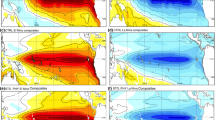Abstract
Based upon the stochastic resonance theory, the formation mechanism of 100-kyr cycles in climate system is numerically studied in the perspective of stochastic dynamics. In this study, firstly we combine the idealized albedo model with the geological evidence and observation in climate system to construct a new albedo model. Secondly, a bistable nonlinear system is constructed by introducing the albedo model into zero-dimensional energy balance model. Finally, based on this new system, with the solar radiation cycles and stochastic perturbation simultaneously taken into account, the variation of 100-kyr cycles is analyzed by numerical simulations. The results show that, when the noise intensity reaches a certain value, the stochastic resonance can be triggered. However, the noise intensity in this level does not exist in the actual climate system. In order to explain the formation mechanism of 100-kyr glacial-interglacial cycles forced by the weak solar radiation cycles, besides the solar radiation stochastic perturbation, the stochastic dynamic effects of the other “non-solar” radiation stochastic perturbation in the climate change processes should also be considered. The stochastic dynamic simulations taking the two types of stochastic perturbation into consideration show that, when the two types of appropriately observable stochastic perturbation are introduced, the stochastic resonance also can be generated. In this situation, the contribution rate of solar radiation stochastic perturbation is about 38%, which proves the importance of solar radiation stochastic perturbation in the formation of 100-kyr climate cycles.
Similar content being viewed by others
References
Benzi R, Parisi G, Sutera A, et al. 1982. Stochastic resonance in climatic change. Tellus, 34: 10–16
Benzi R, Parisi G, Sutera A, et al. 1983. A theory of stochastic resonance in climate change. SIAM J Appl Math, 43: 565–578
Berger A. 1988. Milankovitch theory and climate. Rev Geophys, 26: 624–657
Braconnot P, Otto-Bliesner B, Harrison S, et al. 2007. Results of PMIP2 coupled simulations of the Mid-Holocene and Last Glacial Maximum-Part 2: feedbacks with emphasis on the location of the ITCZ and mid-and high latitudes heat budget. Clim Past, 3: 279–296
Bryant E. 1997. Climate Process and Change. Cambridge: Cambridge University Press. 209
Cao H X. 1994. Climate Dynamic Model and Simulation (in Chinese). Beijing: China Meteorological Press. 320
Gurney R J, Foster J L, Parkinson C L. 1993. Atlas of Satellite Observations related to Global Change. Cambridge: Cambridge University Press. 470
Hu G. 1994. Stochastic Force and Nonlinear System (in Chinese). Shanghai: Shanghai Scientific & Technical Education Press. 263
Huang J P. 1992. Theoretical Climate Model (in Chinese). Beijing: China Meteorological Press. 135
Lean J, Rind D. 1998. Climate forcing by changing solar radiation. J Clim, 11: 3069–3094
Matteucci G. 1989. Orbital forcing in a stochastic resonance model of the late-Pleistocene climate variations. Clim Dyn, 3: 179–190
Milankovitch M, 1941. History of Radiation on the Earth and Its Use for the Problem of the Ice Ages. K Serb Aka Beogr Spec Publ. 142
Pan S W. 1994. Principle of Modern Climatology (in Chinese). Beijing: China Meteorological Press. 1182
Shi G Y, Liu Y Z. 2006. Progresses in the Milankovitch theory of Earth’s climate change (in Chinese). Adv Earth Sci, 21: 278–285
Yu G, Liu J, Xue B. 2007. Palaeoclimate Dynamic Simulation (in Chinese). Beijing: Higher Education Press. 337
Zhou X J. 1964. Research on the Microphysical Mechanism of the Warm Cloud (in Chinese). Beijing: Science Press. 417
Zhou X J. 2005. Atmospheric stochastic dynamics and predictability (in Chinese). Acta Meteorol Sin, 63: 806–811
Author information
Authors and Affiliations
Corresponding author
Rights and permissions
About this article
Cite this article
Duan, M., Zhou, X. Stochastic dynamic simulation of the 100-kyr cycles in climate system. Sci. China Earth Sci. 58, 420–428 (2015). https://doi.org/10.1007/s11430-014-5031-0
Received:
Accepted:
Published:
Issue Date:
DOI: https://doi.org/10.1007/s11430-014-5031-0




